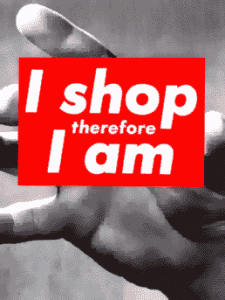Art Movements: Neo-conceptual art
Neo-conceptual art

Barbara Kruger, I Shop, Therefore I Am
Neo-conceptual art describes art practices in the 1980s and particularly 1990s to date that derive from the conceptual art movement of the 1960s and 1970s. These subsequent initiatives have included the Moscow Conceptualists, United States neo-conceptualists such as Cindy Sherman and the Young British Artists, notably Damien Hirst and Tracey Emin in the United Kingdom, where there is also a Stuckism counter-movement and criticism from the 1970s conceptual art group Art and Language.
History
Many of the concerns of the “conceptual art” movement proper have been taken up by many contemporary artists since the initial wave of conceptual artists. While many of these artists may not term themselves “conceptual artists”, ideas such as anti-commodification, social and/or political critique, digital art, and ideas/information as medium continue to be aspects of contemporary art, especially among artists working with computer art, installation art, performance art, net.art and electronic art. Many critics and artists may speak of conceptual aspects of a given artist or art work, reflecting the enduring influence that many of the original conceptual artists have had on the art world.
The Moscow Conceptualists, in the 1970s and 80s, attempted to subvert socialist ideology using the strategies of conceptual art andappropriation art. The central figures were Ilya Kabakov and Komar and Melamid. The group also included Eric Bulatov and Viktor Pivovarov.
Notable U.S neo-conceptual artists of the 1980s include Sherrie Levine, Jenny Holzer, Richard Prince, Louise Lawler, Cindy Sherman, Mark Lombardi, Barbara Kruger, and expatriate Briton, John LeKay who exhibited with Damien Hirst.
The Young British Artists (YBAs), led by Damien Hirst, came to prominence in the 1990s and their work was described at the time as neo-conceptual, even though it relies very heavily on the art object to make its impact. The term is used in relation to them on the basis that the object is not the artwork, or is often a found object, which has not needed artistic skill in its production. Tracey Emin is seen as a leading YBA and a neo-conceptualist, even though she has denied that she is and has emphasised personal emotional expression. Charles Harrison, a member of the conceptual art group Art and Language in the 1970s, criticizes the neo-conceptual art of the 1990s as conceptual art “without threat or awkwardness” and a “vacant” prospect.
Other notable artists associated with neo-conceptualism in the UK include Martin Creed, Liam Gillick, Bethan Huws, Simon Patterson, Simon Starling and Douglas Gordon.


This Post Has 0 Comments